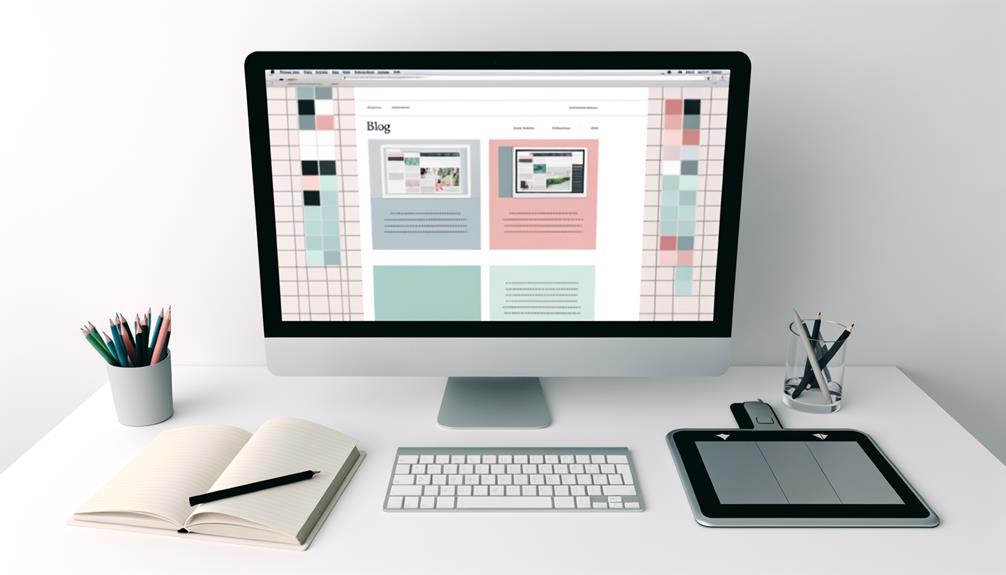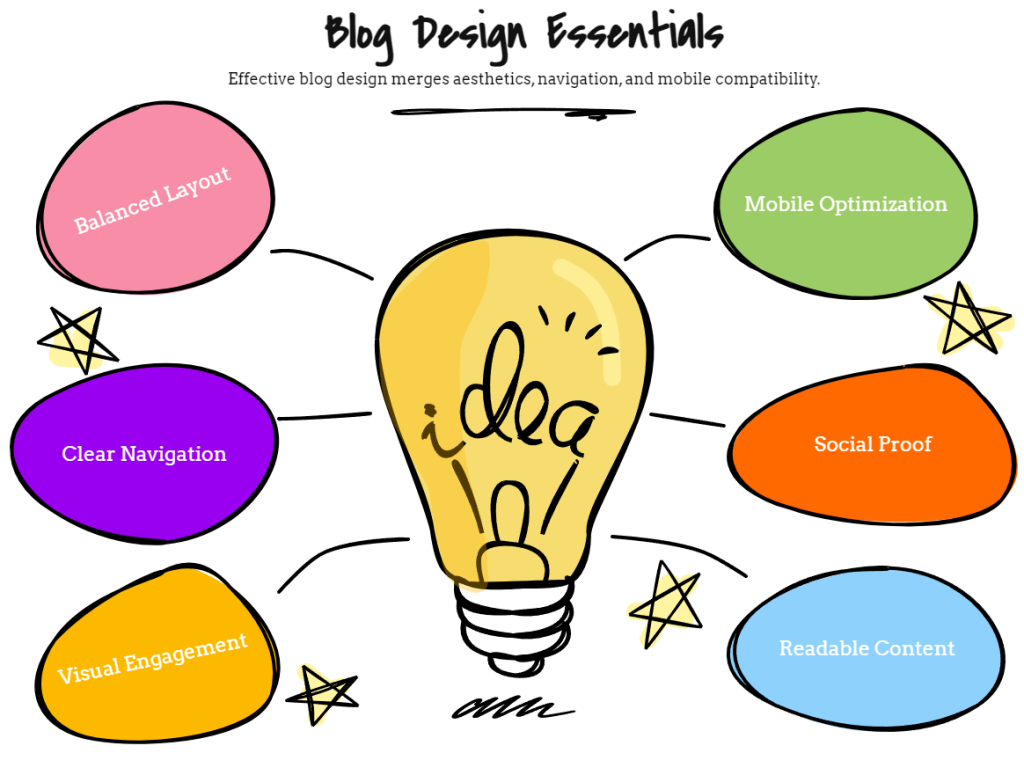

Creating a successful blog[2] isn’t just about writing content. It’s about how you package it too. Think of your blog design like the window display of a store. You want it to be eye-catching, appealing, and inviting. To do that, consistency is key. Keep the same colors and fonts going.
But a blog isn’t just a pretty face. It needs to be easy to use too. Make sure it’s not just user-friendly, but mobile-friendly as well. This makes your readers stick around longer, trusting your content more.
And don’t forget the importance of readability. Break up text with images or infographics. This makes it less overwhelming and more enjoyable for your readers.
Being seen is also key. Incorporate SEO strategies to ensure your blog shows up in search results. And to engage your readers, include clear calls-to-action and show off those positive reviews or testimonials.
Lastly, keep an eye on your blog’s performance. Always be on the lookout for areas you can improve.
Want to learn more about these elements and how to put them into practice? Stay tuned for our next post.
And guess what? There’s more to discover about effective blog design. Stay tuned to find out!
What are the building blocks of blog design, and why do they matter?
The heart of blog design lies in three things: layout, typeface, and color. They work together to make your blog look good. It’s key to know what your users want when you’re setting up your content.
Your layout should be easy to use. Your typeface and color should make your blog easy to read and nice to look at. Your blog’s look is also a way to show who you are as a brand and earn trust from your readers.
A well-thought-out design that stays the same across your blog can help get users involved. So, understanding these basics is key to a successful blog. They shape how users interact with your blog and how involved they get.
But is there more to blog design than just these basics? Let’s go deeper in the next section.
Understanding blog design is just the beginning. The real magic happens when we realize how much user experience impacts blog engagement and success. A blog layout, designed with the reader in mind, is crucial to web design. It makes your blog easy to navigate and boosts your online visibility.
Imagine having a search bar right where you need it. It’s like a silent guide, directing readers to the content they need swiftly.
Think about the first time you meet someone – impressions matter, right? The same goes for your blog’s design. A professional, user-friendly design can keep your audience coming back for more.
We all know content is King. But what if your readers can’t access your content on their mobile devices? With the rise in mobile internet[3] usage, it’s vital to ensure your blog is mobile-friendly.
Want to connect more with your readers? Here’s how. Start with making your blog easy to use. Add clear, straight-to-the-point calls-to-action. What’s a call-to-action? It’s a prompt that tells your reader what to do next.
Next, sprinkle in some social proof. Think of it like adding a pinch of salt to your favorite dish. Testimonials from readers who’ve been there and done that can boost your blog’s credibility.
Got a fancy for multimedia? Use it. Mixing in photos, videos, and infographics can make your content more interesting. It’s like tossing in different flavors to make a meal more enjoyable. Plus, it caters to different reader preferences.
Let’s not forget readability. It’s like finding a cozy reading nook. A clean design, comfortable font sizes, and organized subheadings can make your blog a delightful place to be.
Lastly, don’t hide the social share buttons. It’s like inviting people to a party. The more, the merrier.
Here’s the bottom line: a well-crafted blog design can help you connect more with your readers. But wait, there’s more to it. Stay tuned for the next tips on maximizing your blog engagement. Exciting, isn’t it?

What’s the secret recipe for getting more eyes on your blog? It’s all about blending the right ingredients:
Linking up with influencers and guest posting on similar blogs can also help get your content out there. But remember, it’s not just about the numbers. It’s about connecting with readers who value what you’ve got to say.
Don’t let SEO challenges hold back your business. Partner with us for cutting-edge SEO solutions that drive traffic and enhance visibility. Visit our contact page to learn more, or connect with us on WhatsApp for immediate support and start seeing results!
Visual elements are like secret weapons in the blog universe. They’re more than just pretty decorations. They have jobs to do.
| What You See | What It Does |
|---|---|
| Brand Pictures | Makes your blog unforgettable |
| Infographics and Graphs | Breaks down tricky information |
| Quality Photos | Boosts sharing on social media |
| Font Sizes, Colors, Distances | Directs the reader’s eye |
The layout of a blog – the sizes, colors, and gaps between words – it all guides your reader’s eye to the good stuff. It makes your blog a pleasure to navigate. Infographics and graphs take complicated info and make it friendly and fun. All this to say, knowing how to use visuals in your blog isn’t just handy, it’s vital.
But here’s the question: What’s the real secret to a blog’s success? Stay tuned to find out.
Let’s talk about how to make your blog appealing and engaging: we’re diving into the art of effective content layout.
Curious about what comes next in crafting the perfect blog? Stay tuned for more tips!
Yes, the look and feel of your blog matters. Yes, the content you post is important. But, do you know what else counts? Understanding your blog traffic. Studying blog traffic helps you know your readers better and tweak your marketing plans. You can track things like the number of page views, how quickly readers leave your site, and how long they stick around. These numbers show how well your blog is doing.
Wondering where your readers are coming from? Look at your traffic sources. Whether they find you through a simple Google search[1] or a Facebook[4] post, knowing this helps you promote your blog better. You can also track how many readers are clicking on your links and converting into leads. This shows how effective your content is in driving actions.
Keep a close eye on these numbers. They’ll help you fine-tune your blog and align it with what your readers want. This way, you’ll make your marketing efforts more successful. But there’s more to it than just numbers. Want to know the secret? Stay tuned…
The three must-haves for any blog are: regularly updating with fresh material, engaging your readers, and a visually pleasing design. When you pair these with simple SEO tricks and social media buzz, you create a blog that people want to read. But what’s the key to making all of this work together? We’ll reveal that secret next time. Stay tuned!
To write a superb blog article, there are five key things you need to keep in mind. First, dig deep into your topic. Know it inside out. Second, understand your audience. Figure out what they crave for. Third, structure your content so it’s easy to follow. Fourth, use headlines that grip people’s attention. And lastly, make it visually pleasing. Remember to use SEO techniques to make your article visible in search engines. Consistency is key in posting. Don’t shy away from sharing your thoughts on social media. Always respond to comments and take your audience’s feedback seriously. And here’s a secret: there’s more to learn about successful blogging. Stay tuned for our next post.
A great blog layout? It’s all about being mobile-friendly, easy to navigate, and clever with content placement. Think about the theme, the visual order of things, the colors you use, and the style of your text. It’s important, too, to be smart with your sidebar and footer design. Together, they can make your blog a joy to use. Want to know a secret? There’s one more key component to the perfect blog layout. Stay tuned to find out what it is!
When designing a blog, pick colors that are easy on the eyes and fonts that are easy to read. Make sure your blog is easy to navigate, looks good on mobile devices, and that your content is organized in a logical way. Use pictures to help tell your story, and include interactive features to engage your readers. Don’t forget to make it easy for readers to share your content on social media, and be sure to keep search engine optimization in mind. And just when you thought you’re done, remember – there’s always more to learn and improve in the exciting world of blog design. Stay tuned!
